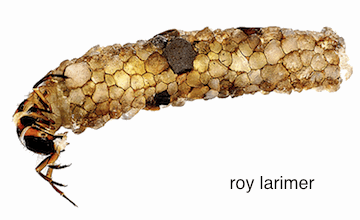DNA barcoding maps unknowns in Iraq
Rivers and streams are listening devices for watersheds. The best way to assess watershed health is to survey freshwater life downstream. In particular, benthic (bottom-dwelling) macroinvertebrates (visible without magnification) are widely-used indicators of freshwater quality (see for example US EPA page). A challenge for freshwater biomonitoring programs is to rapidly identify the multitude of benthic invertebrate species potentially present in a water sample, and to repeat that for hundreds or thousands of samples. Now imagine you need to assess freshwater quality where few taxonomists have ever ventured.
 In January 2011 J N Am Benthol Soc, researchers from U.S. National Museum of Natural History, The American University of Iraq-Sulaimani, and University of Guelph report on DNA barcoding to facilitate biomonitoring in the headwaters of the Tigris River, Iraq. Geraci and colleagues focused on Trichoptera (caddisflies) a group widely used as water quality indicator species. Trichoptera are small, winged insects (approximately 12,000 named caddisfly species worldwide) related to moths and butterflies, with larval stages that develop in freshwater. Sometimes emulated by trout fishermen making lures, caddisfly larvae construct “mobile homes” by gluing together bits of stone, sticks, or other material, with architectural details that help distinguish species. At the time of this study, the world literature on Iraqi Trichoptera consisted of 3 published reports describing 6 species in 7 genera (some larvae were identified only to genus) based on specimens collected between 1919 and 1987.
In January 2011 J N Am Benthol Soc, researchers from U.S. National Museum of Natural History, The American University of Iraq-Sulaimani, and University of Guelph report on DNA barcoding to facilitate biomonitoring in the headwaters of the Tigris River, Iraq. Geraci and colleagues focused on Trichoptera (caddisflies) a group widely used as water quality indicator species. Trichoptera are small, winged insects (approximately 12,000 named caddisfly species worldwide) related to moths and butterflies, with larval stages that develop in freshwater. Sometimes emulated by trout fishermen making lures, caddisfly larvae construct “mobile homes” by gluing together bits of stone, sticks, or other material, with architectural details that help distinguish species. At the time of this study, the world literature on Iraqi Trichoptera consisted of 3 published reports describing 6 species in 7 genera (some larvae were identified only to genus) based on specimens collected between 1919 and 1987.
As part of a larger “Key Biodiversity Areas” survey (for more info, see note below) conducted from 2007 to 2009 by Nature Iraq Organization, the researchers collected benthic macroinvertebrates at twenty sites in three watersheds of the Tigris River during May-June 2008 and January 2009. Four to six replicate samples were obtained at each site, samples were washed with 70% ethanol using a 0.5 mm mesh in the field and again in the laboratory, and caddisfly larvae were removed and stored in 70% ethanol. At two sites adults were collected and placed in separate vials with 70% ethanol. Larvae were sorted using keys for Nearctic and Palearctic Trichoptera, and adults were identified to genus following a key to European species.
Following morphologic sorting, DNA barcoding using standard primers (LepF1/LepR1) was performed on 144 larvae and 6 adults, focusing on individuals in family Hydropsychidae as these were collected in large numbers. Successful amplification was obtained on the first pass with 81.3% of specimens, which is a nice demonstration of robust nature of DNA itself and of amplification protocols, as storage conditions were not what is considered optimal (optimal storage for insects usually means dried immediately after collection, whereas these specimens were stored in 70% ethanol for 2-3 years at the time of analysis).
DNA barcodes of Iraqi specimens were compared to the existing Trichoptera barcode library which so far includes records for about 2500 named species (~19% of world fauna) and many undescribed species. Combining morphologic and DNA data, the researchers identified 16 species in 11 genera and 9 families, with only one of the putative species matching to a previously named organism. There is a lot of Trichoptera taxonomy and molecular phylogeny here, but I will skip to conclusion. This study demonstrates how DNA barcoding, applied to a “virtually unknown fauna”, can build on an existing barcode library to speed species recognition, establish a practical identification method for general use, and link new discoveries to known genera and families. The authors conclude that “DNA barcoding of benthic macroinvertebrates will be crucial in developing countries that are trying to overcome a lack of knowledge of aquatic-insect taxonomy and trained taxonomists. DNA barcoding will help aquatic scientists in these countries generate the empirical data needed to implement sound bioassessment and monitoring protocols to protect and manage their water resources.”
More generally, I think we can stop looking back longingly at past taxonomic practices and, DNA tools in hand, start helping society and science discover just what is out there, with all the intellectual excitement that entails.
Note added 20 March 2011: Co-author Mohammed Al-Saffar writes: “Key Biodiversity Areas (www.natureiraq.org/site/en) is an ongoing project conducted biannually by Nature Iraq, and we (Nature Iraq, Miami University, Smithsonian NMNH, Guelph University, as well as Clemson University) are in the process of working on the DNA barcoding of all the insects important for monitoring water quality in Iraq such as the Mayflies, Dragonflies, etc.”
This entry was posted on Saturday, March 19th, 2011 at 10:09 pm and is filed under General. You can follow any responses to this entry through the RSS 2.0 feed. Both comments and pings are currently closed.